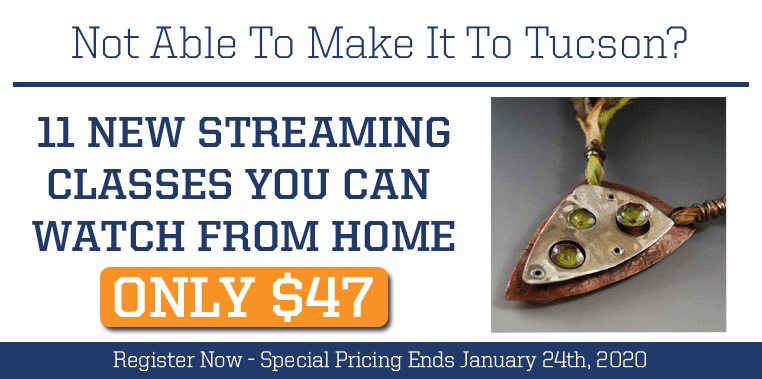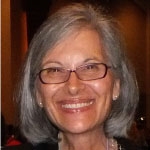2013 Instructor Interview - Eva Sherman
Discover Mixed Media Jewelry Making with Eva Sherman
Eva Sherman says she spends most days in the studio happily fooling with wire and metals. But Eva does a lot more than fool around: she's written tutorials, been featured in magazines, and is sharing her wire and metal techniques with us in Tucson this February. If you haven't seen one of Eva's raw, beautiful fold-formed cuffs (see below), you've found one new type of jewelry to love!
Eva sat down for an interview with Heather, our Classes Coordinator, to talk about her metal fold-formed and wire jewelry, and what her classes are going to be like in Tucson as well as what inspires her. Or, scroll down to read a complete transcript!
(audio not playing? click here)
Hint: You may be asked to confirm your email address after filling out this form. You will get the 2nd interview tomorrow. Please make sure customerservice@jewelrytools.com is added to your email addressbook or contacts list, because that will help our email get through to you!
Click below to explore Eva's Classes this February in Tucson:
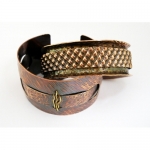 Buffed and Cuffed Feb. 2, morning  |
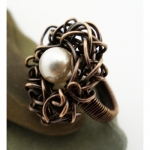 Birds Nest Ring Feb 2, afternoon  |
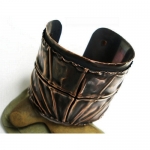 Fold Forming 101 2 Chances to take this class: Feb. 7, afternoon  Feb. 9, afternoon  |
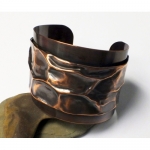 Fold Forming 102 Feb. 7, afternoon  |
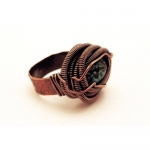 Beauty is in the Eye of the Beholder Feb. 8, morning  |
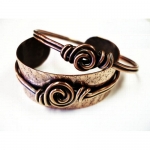 Rosette Cuff & Bangle Feb 8, afternoon  |
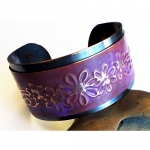 Embossed Cuffs Feb 9, morning  |
Transcript of our interview with Eva Sherman
Eva: I'm doing great Heather, how are you?
Heather: I'm doing good, thank you. We'll get started here, what medium do you primarily work in?
Eva: Currently I primarily work in metals, but it's been an evolution from wire, and that actually started back with beading, so it's been a process.
Heather: Great! What tools do you use most often?
Eva: My most favorite tool is torches and hammers, and it's very therapeutic to beat metal into submission.
Heather: There ya go! Have you ever improvised or repurposed a tool?
Eva: Actually yes. In fact one of the classes I'm teaching is embossed cuff bracelet and what I did was I took a scrapbooking tool, which is an embosser, and I put metal through it. I started with very thin-gauge metal because it's actually designed to work with paper, and I worked my way up to 24-gauge. And I have found that you can use the scrapbook embosser tool with up to 24-gauge metal and you'll get a decent imprint, it won't be really sharp and crisp, but it'll be enough to show the effect.
Heather: Neat. What is your favorite way to finish a piece, or your favorite effect?
Eva: Most of my pieces are done with copper and liver of sulfur, or sometimes I will add a metal patina paint, like Vintaj makes those, a nice series of colors. And then lately what I've started doing is spraying them with an acrylic enamel spray, and that was a hint I got in a class. It's the same stuff that they finish your car exterior, with so it's a nice heavy-duty finish.
Heather: Great. What advice would you give to a beginner who's maybe a bit intimidated by how intricate the process seems?
Eva: I would say take classes, do some research on the internet. There's tons of really great YouTube videos out there and just watch how other people do it, but I find that taking classes is the best way, because it's interactive and you can ask a question and there are things that instructors have in their head that they maybe forget to say on a YouTube video - but if you ask them in person, you'll get some good hints and tips like the one I just told you, about using the acrylic enamel spray.
Heather: What gives you inspiration to try new things? What keeps you motivated?
Eva: New things are what keep me motivated. I find that doing the same thing, time after time, you get a little bored. I think most artists have a touch of ADD and we want to try different things, and I've also found that while I'm a jewelry artist, if I take a sewing class or something in another medium, that will do something in my brain that will give me a little idea of how I can adapt that technique into my medium. So, I think taking classes.
Heather: Once you make a piece and you're happy with it where does it go?
Eva: Usually my first piece, my prototype, is mine. I own a gallery, so I sell a lot of work through my gallery. I have an Etsy site, although I don't keep it very updated very well. You know, I try to sell my work to support my habit!
Heather: That's great. Have you ever rescued a piece that seemed like it was broken?
Eva: All the time. Most artists I think have UFOs. The unfinished objects pile, anything that is unfinished/broken/lost the momentum, goes into this pile. And sometimes, just picking something up out of there and looking at it on a different day will give you an idea, and then you can take it apart/repurpose it/fix it/adapt it/whatever.
Heather: You're originally from Hungary and you were also an architect in the past, from your perspective have those experiences influenced your art and design?
Eva: My architectural background, I learned to design in architecture school. We specifically adapted those principal of design to creating buildings, but we have found that the principals of design, they're adaptable. If you know how to design, then you can design a building, you can design a lampshade, you can design jewelry, it's the same principals.
And as far as being Hungarian, my parents were both sort of artistic, so I think I got some of this from them. My dad was a sculptor in clay and my mom, all my life, did and still does handiwork. She does embroidering, tatting, sewing, so she's more of a fabric artist - but a lot of Hungarian women particularly do a lot of the handicrafts, work with thread and embroidery, floss, and things like that.
Heather: That's cool. How did you discover fold forming? Was there an "aha" moment when you knew this was going to lead to something really interesting?
Eva: Well when I saw it, it appealed to my sense of design, because I like raw and organic forms. So I bought this book by Charles Lewton-Brain. I started working my way through it, and then last year I had an opportunity to take a class with him, and that was my "aha" moment, because that man is really a genius of geniuses! And if I knew 1% of what he knows, I would be very happy. If you are interested in fold forming and ever have an opportunity to take a class with him, then I would highly recommend it. I've learned a bit just on my own with experimenting and classes, but I feel like I just know a tiny fraction of what he knows.
Heather: What's your secret? What do you like to do to make sure your bracelets fit perfectly?
Eva: I'm into cuffs these days, so I kind of have a small, medium, and large template that I can create from and I know that on my bracelet mandrel I can mark, this is small, this is medium, and this is a large.
I typically work with a 6 inch blank because although for really large, like an extra large, it's not big enough, but I can trim it for a small. It works really nice for a medium and I can open it up enough to where it fits a large. So I guess my secret is to make marks on your bracelet mandrel at the correct size that works for you, and then always make it at that spot.
Heather: How would you describe your style, both your jewelry style and your creative process?
Eva: I think my jewelry style is a little bit organic and raw and I like things that are not real fine and precise.
I think that goes with my creative process: because I have a very limited attention span, I like to knock things out quickly, and so if you're doing something technical, that just takes longer than I'm willing to pay attention, so it kind of goes together a bit. Raw, organic, you know; not fine silver-smithing, but a lot of cold connecting, a lot of forging and moving of metals.
Heather: Cool! Well thanks so much for your time and sharing this knowledge with everybody. We are extremely excited to have Eva teaching with us in Tucson and her classes are filling up! They are so popular so if you are interested please go to the website and get registered. Thank you so much Eva, thanks for spending the time with us!
Eva: Thanks Heather! See you in a couple weeks.
Don't Miss Eva in Tucson!
 Buffed and Cuffed Feb. 2, morning  |
 Birds Nest Ring Feb 2, afternoon  |
 Fold Forming 101 2 Chances to take this class: Feb. 7, afternoon  Feb. 9, afternoon  |
 Fold Forming 102 Feb. 7, afternoon  |
 Beauty is in the Eye of the Beholder Feb. 8, morning  |
 Rosette Cuff & Bangle Feb 8, afternoon  |
 Embossed Cuffs Feb 9, morning  |


 My Cart (Empty)
My Cart (Empty) 

